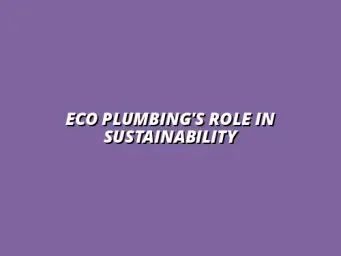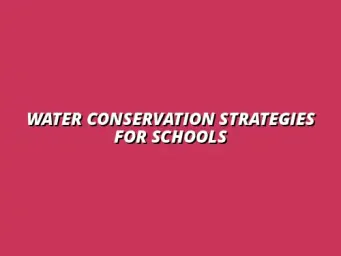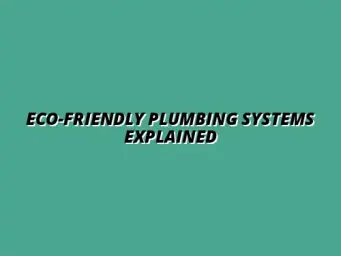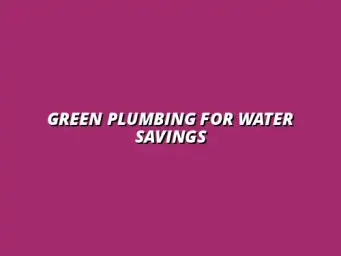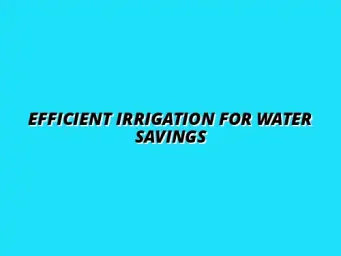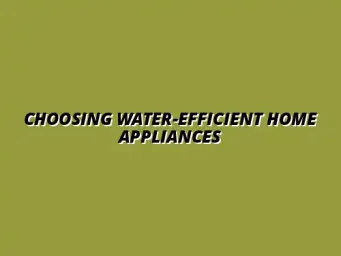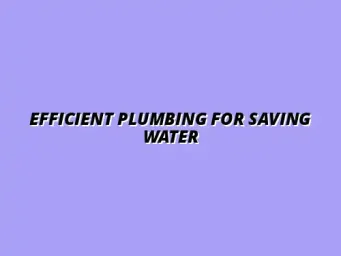Understanding the Importance of Water-Saving Habits for Lower Utility Bills
Water has become one of our most valuable resources, and understanding how to conserve it can lead to significant reductions in our monthly utility bills. By adopting water-saving habits, we can not only save money but also protect the environment. Let’s dive into how our water consumption impacts household expenses and explore the benefits of conserving water. For practical tips on saving water at home, check out these water-saving tips.
The Impact of Water Consumption on Household Expenses
Every drop counts! The amount of water we use each month directly affects our utility bills. When we become aware of how our habits influence water consumption, we can make better choices that lead to savings.
Analyzing Your Water Bill: Key Components
Your water bill typically includes various components that can impact your total cost. Key elements include:
- Base Rate: A fixed charge for having the service.
- Usage Charges: Costs based on the amount of water consumed.
- Fees and Taxes: Additional charges imposed by the municipality.
By understanding these components, you can pinpoint areas where savings can be achieved through more mindful water usage.
How Water Usage Affects Monthly Utility Costs
Water usage can significantly influence your monthly utility costs. If you regularly use water for tasks like laundry, showering, and watering the garden, these activities can add up. For instance:
- Running a shower for 10 minutes can use about 25 gallons of water.
- Washing clothes can consume around 40 gallons per load.
- Watering your lawn may require over 60 gallons in a single session.
By becoming more aware of these numbers, you can adjust your habits and ultimately lower your bills! Upgrading your plumbing fixtures can also make a big difference. Learn more about water-saving plumbing tips.
Environmental and Financial Benefits of Conserving Water
The benefits of conserving water go beyond just saving money. Every action we take to reduce our water consumption contributes to a healthier environment. Embracing water-saving practices can lead to significant financial and ecological advantages!
Reducing Your Carbon Footprint Through Water Conservation
Conserving water is an essential way to lower your carbon footprint. Water treatment and distribution consume a lot of energy, so when we use less water, we also reduce energy use. To put it simply, the less water we consume:
- Decreases energy needed for heating.
- Reduces the energy required for water treatment.
- Helps in lowering greenhouse gas emissions.
By practicing water conservation, you help protect the planet and contribute to a more sustainable future! Maintaining your water heater efficiently is another key step. Check out these tips on how to maintain your water heater efficiently.
Long-term Savings on Utility Bills and Environmental Impact
Implementing water-saving habits can lead to long-term financial savings on your utility bills. Over time, even small changes can yield significant savings, helping you keep more money in your pocket. Some long-term benefits include:
- Lower monthly bills due to reduced water usage.
- Fewer fees related to excess water consumption.
- Enhanced property value through sustainable practices.
Overall, the practice of water conservation not only boosts your wallet but also contributes to a healthier ecosystem! Extending the life of your home's plumbing can also save you money in the long run. Discover helpful tips on extending your home's plumbing life.
Addressing Common Questions About Water-Saving Habits
When it comes to water conservation, many people often wonder how much water they can actually save by changing their daily habits. The truth is, even small adjustments to your routine can add up significantly over time! It's important to explore the cumulative effects these changes can have, not just on your utility bills but also on the environment. For comprehensive strategies on effective water conservation, visit this page on effective water conservation at home.
For instance, if every household made a few simple changes, the savings could be monumental. From shorter shower times to turning off the tap while brushing your teeth, each little effort contributes to a larger impact. Let's dive deeper into how even the smallest changes can lead to substantial water savings!
How Much Water Can You Save by Changing Daily Habits?
Understanding the cumulative effects of small changes is crucial when it comes to saving water. For example, if each person in a family saves just 5 gallons of water a day, that could translate to 1,825 gallons a year! Here are some common habits that can lead to significant savings:
- Limiting shower time to 5-10 minutes.
- Using a broom instead of a hose to clean driveways.
- Running dishwashers and washing machines only on full loads.
Every drop counts, and when many people make these changes, it leads to a much greater conservation effect. This is why understanding and implementing these daily habits is essential for effective water savings. Discover the numerous benefits of eco-friendly plumbing by visiting this page on eco-friendly plumbing.
Case Studies: Real-Life Examples of Water Savings
Let’s take a look at some real-life examples of how families have successfully saved water through deliberate changes. Many households have reported significant reductions in their water bills after adopting new practices!
- A family in California reduced their water bill by 30% by installing low-flow showerheads and fixing leaks.
- In Texas, a couple saved over 50 gallons a week just by changing how they watered their garden.
- A household in Florida switched to native plants, resulting in a 40% reduction in outdoor water usage.
These case studies highlight that anyone can make a difference! Simple modifications in daily habits not only lead to financial savings but also contribute positively to the environment.
Are Water-Saving Fixtures Worth the Investment?
One of the most frequent questions about water conservation revolves around whether investing in water-saving fixtures is really worth it. While the upfront costs may seem daunting, considering the long-term benefits is essential. Many families find that their savings on water bills quickly offset the initial expense.
For example, low-flow toilets and faucets can lead to substantial reductions in water consumption, which translates to lower bills. Let's break down the analysis of cost versus savings!
Analyzing Cost vs. Savings: Long-term Benefits of Upgrading
When you’re thinking about upgrading to water-saving fixtures, it’s important to evaluate the financial implications. Here’s a quick breakdown of potential costs and savings:
| Fixture | Initial Cost | Savings per Year |
|---|---|---|
| Low-flow Toilet | $200 | $150 |
| Low-flow Showerhead | $30 | $50 |
| Water-efficient Faucet | $25 | $30 |
By using this table, you can see that while the initial costs vary, the potential savings over time can lead to a positive return on investment. Investing in water-saving fixtures often pays off in the long run!
Evaluating the Return on Investment for Water-Efficient Appliances
Finally, let’s consider the return on investment for water-efficient appliances. Many modern appliances are designed to conserve water while still being effective. Here are some benefits to consider:
- Lower utility bills each month.
- Potential rebates and incentives from local governments.
- Increased property value due to energy-efficient upgrades.
It becomes clear that the long-term financial and environmental benefits make water-saving fixtures a worthwhile investment. Embracing these changes can lead to a more sustainable lifestyle while helping you save money! For professional plumbing services in Tyseley, Birmingham, consider contacting a local plumber.
Strategies for Sustaining Water-Saving Practices Long-Term
Implementing water-saving habits is just the beginning; sustaining these practices long-term is essential for continued benefits! Creating a structured action plan can help you stay on track. It is important to set specific, achievable goals that align with your household's needs.
A water-conservation action plan can keep everyone in the house on the same page. This ensures that everyone understands their role in conserving water, making it easier to maintain these habits over time.
Creating a Water-Conservation Action Plan for Your Household
To create an effective water-conservation action plan, start by setting realistic goals. Here’s how you can strategize:
- Identify areas where water usage can be reduced.
- Set specific savings targets (like reducing water use by 20% in six months).
- Assign responsibilities to family members for different tasks.
By having clear goals and responsibilities, your family can work together toward a common purpose, making it easier to achieve water conservation objectives!
Engaging Family Members in Water-Saving Efforts
Engaging everyone in your household is key to the success of your water-conservation action plan! Here are some tips for involving family members:
- Hold regular family discussions about water usage.
- Incorporate fun challenges, like a “no-water waste week.”
- Celebrate milestones together as a family.
When everyone is involved, it fosters a sense of teamwork and accountability, making it more likely that these habits will stick!
Resources and Tools for Tracking Your Water Usage
As you implement these water-saving habits, utilizing resources and tools can significantly help in monitoring your progress. Technology offers many options to help you keep an eye on your water consumption!
Incorporating apps and gadgets into your routine makes tracking water usage much easier. Here are some suggestions for tools you can explore:
- Water usage monitoring apps that sync with your water meter.
- Smart home devices that track and manage water flow.
- Printable water conservation calendars for daily reminders.
By leveraging these tools, you can stay informed about your water usage and make adjustments as needed.
Community Programs and Initiatives to Support Water Conservation
Don't forget about the power of community! Many local governments and organizations offer programs aimed at supporting water conservation efforts. Participating in these initiatives can provide additional resources and motivation!
- Join local water conservation groups for support and ideas.
- Attend workshops or seminars on water-saving techniques.
- Participate in community challenges to reduce water consumption.
By getting involved, you not only enhance your own efforts but also inspire others around you to recognize the importance of saving water!
Reflecting on the Impact of Your Water-Saving Habits
Finally, reflecting on your progress is crucial for understanding the impact of your water-saving habits. Taking the time to analyze your water usage over time helps you see how far you've come!
Measuring success can motivate your household to continue on this path of conservation. Recognizing your achievements reinforces the positive behaviors and encourages ongoing efforts!
Measuring Success: Evaluating Your Water-Bill Reduction
To effectively measure your success, evaluate your water-bill reduction regularly. Here are a few steps to help you assess your progress:
- Keep track of your monthly water bills to see trends.
- Calculate the percentage of reduction compared to past bills.
- Identify which changes have had the most impact.
By following these steps, you'll have a clearer picture of your water-saving journey and can celebrate the improvements made.
Analyzing Your Water Use Patterns Over Time
In addition to monitoring bills, analyzing your overall water use patterns can be enlightening. Consider creating a chart or graph to visualize your usage over time. This can help you identify any areas that require more attention or adjustment!
Understanding these patterns allows you to make informed decisions about future water-saving initiatives. A little bit of data can go a long way in reinforcing the importance of your efforts!
Celebrating Milestones: Recognizing Your Conservation Achievements
Lastly, don't forget to celebrate your milestones! Recognizing your conservation achievements can be a fantastic motivator for everyone involved. Consider planning small celebrations or rewards for reaching your goals.
- Host a family gathering to celebrate your water-saving efforts.
- Reward yourself with a small treat after achieving a significant milestone.
- Share your success stories with friends and family to inspire them!
By celebrating, you reinforce the importance of water conservation in your life and encourage continued commitment to these valuable habits!
Encouraging Others to Adopt Water-Saving Habits
Encouraging your friends and community members to adopt water-saving habits can amplify your impact. Sharing your experiences can inspire others to change their own habits!
Here are a few ways to advocate for water conservation in your community:
- Organize a neighborhood meeting to discuss water-saving techniques.
- Create and distribute informative flyers on the benefits of conserving water.
- Use social media to share tips, resources, and personal success stories!
When we work together, we can make a significant difference in water conservation efforts on a larger scale. Let’s spread the word and encourage others to join the movement!
Advocating for Water Conservation Initiatives Locally
Lastly, advocating for local water conservation initiatives can lead to substantial change. By supporting policies that prioritize water-saving measures, you can help create a more sustainable community.
- Attend town hall meetings to voice your support for water-saving legislation.
- Collaborate with local organizations focused on environmental sustainability.
- Volunteer for community clean-up days related to water conservation efforts.
Your involvement can help foster a culture of conservation within your community, ensuring that water-saving habits become a shared priority!


